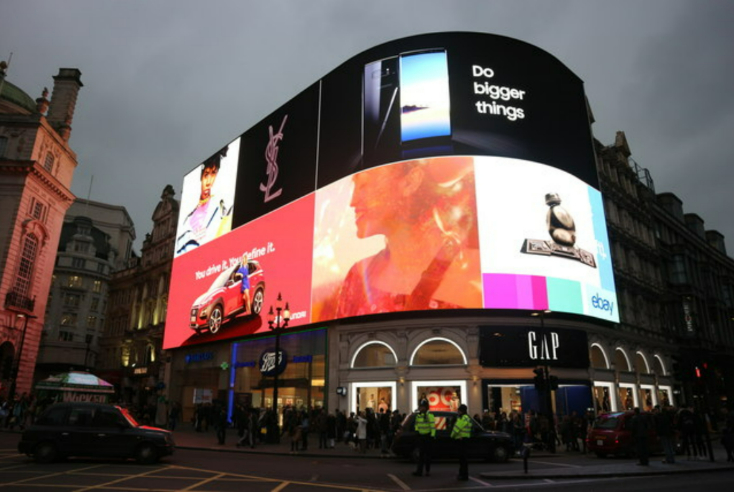Opinion
Contextual relevancy is being brought to a mass medium that has always offered creative opportunities for emotional messaging.
The digital world already entered offline media a few years ago, and the lines between online and offline media are blurring more and more every year.
Digital Out of Home (DOOH) has been with us in key spots such as malls or transport links for a while. But now, JCDecaux has announced that they now offer programmatic digital capabilities across all their environments. Sites at malls, rail sites, street furniture, supermarkets including Tesco, airports including Heathrow and large formats are part of their programmatic OOH inventory, which means a diverse range of brands can tap into this inventory to reach their specific audience.
The programmatic OOH opportunity is now no longer just available in key cities but in the top 30 cities in the UK.
OOH in general is widely accepted by consumers and not regarded as disruptive, and brands are increasingly recognising the strength of DOOH. Kantar’s prediction for 2022 is that brands will increase their DOOH spends by 36%.
OOH has proven to build up awareness as well as push sales, depending on where you position your ads and your messaging. For example, clever planning can place your OOH ads near stores for special offers, openings or events. Alternatively, large sites help drive attention and grow brand awareness. It is one of the most creative and playful channels if a brand dares to stand out.
Agile planning enters the OOH world
Now, with programmatic OOH (prOOH) we are entering the next phase of digitalisation and agile planning for a traditional static channel. This is also a chance for (smaller) brands to tap into very targeted planning more easily to increase contextual relevancy and hence the effectiveness of their campaigns. Even though an ad might be noticed subconsciously, the context in which it is placed and perceived has a large impact on the relevancy of the message for the consumer.
PrOOH allows you to react to weather, sports events and their results, national celebrations or seasonal day events (think Easter, bank holidays, Boxing Day) and send a message live in the matter of an hour. All these elements allow brands to place their message with as much contextual relevancy as possible in order increase their chances of being noticed and for the message to resonate.
For example, Diageo has run a campaign for their Gordon’s gin targeting the audience based on weather and time of day to deliver a message as highly relevant as possible, up to just one hour before airing the creative can be delivered.
Brands can even link their own data such as website traffic or footfall to their stores to programmatic OOH to allow for optimisation. For example, if one area does not bring as much traffic, dial it up or down, depending on the insights you have as a brand.
You can even pause the campaign almost instantly, like you can with digital campaigns. That allows you to react to internal factors such as running low on stock, as well as to external factors such as the death of Queen Elizabeth. You can react in real time and adjust your messaging – again, relevancy is the key here.
Sustainable planning gets one step closer to reality
This leads me to the biggest chance, and what I find most appealing: that OOH campaigns can become more sustainable. The more digital sites there are, the less we need to have ads printed and sent out by cars. DOOH screens can be powered by sustainable energy.
And I need to stress the can here. OOH site owners and providers both need to buy into the commitment to power these sites and servers by renewable green energy.
***
Be aware, programmatic OOH is not equal to programmatic digital videos or banners. PrOOH still sends one message to many, and will and should obviously remain that way due to the nature of the sites being in high footfall areas delivering messages on big screens.
That means it luckily does not get into hyper targeting, which ends up being creepy and oversteps the line. Rather, contextual relevancy is being brought to a mass medium that has always offered creative opportunities for emotional messaging.
 Nina Franck is an independent comms and media planner
Nina Franck is an independent comms and media planner
Strategy Leaders: The Media Leader‘s weekly bulletin with thought leadership, news and analysis dedicated to excellence in commercial media strategy.
Sign up for free to ensure you stay up to date every Thursday.
Adwanted UK is the trusted delivery partner for three essential services which deliver accountability, standardisation, and audience data for the out-of-home industry.
Playout is Outsmart’s new system to centralise and standardise playout reporting data across all outdoor media owners in the UK.
SPACE is the industry’s comprehensive inventory database delivered through a collaboration between IPAO and Outsmart.
The RouteAPI is a SaaS solution which delivers the ooh industry’s audience data quickly and simply into clients’ systems.
Contact us for more information on SPACE, J-ET, Audiotrack or our data engines.





 Nina Franck is an independent comms and media planner
Nina Franck is an independent comms and media planner